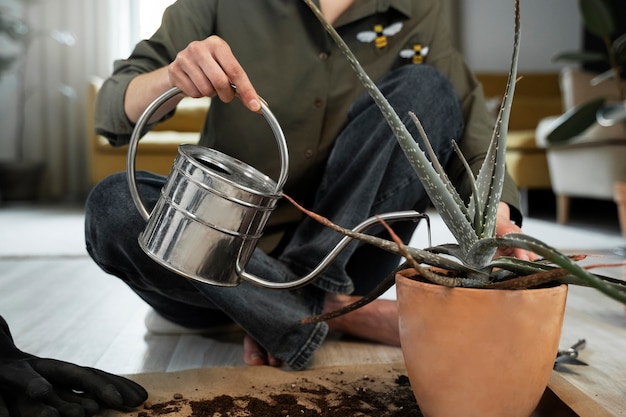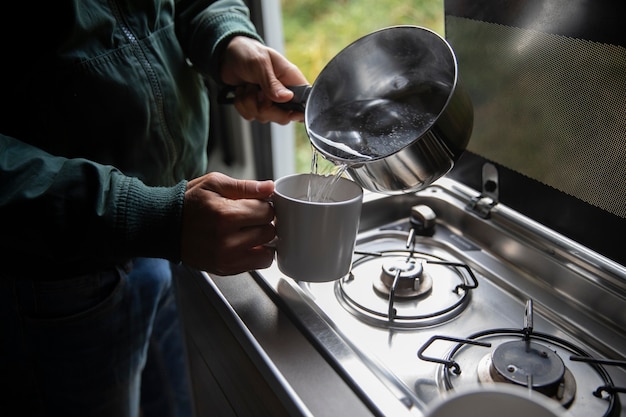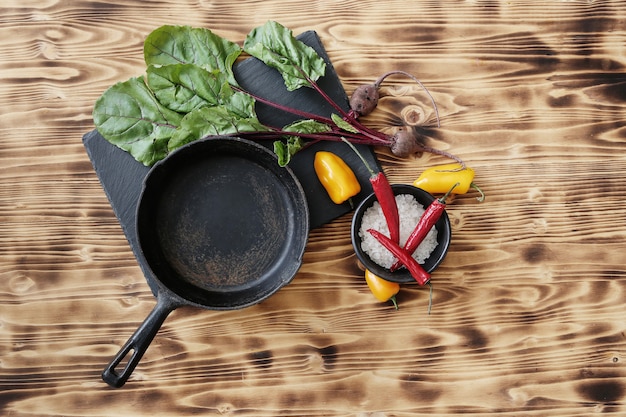stainless steel cookware. It's practically a household name, a kitchen staple that promises durability and sleek looks. But let's be real, it can be a bit of a culinary enigma, a bit like that friend who's always there for you but requires a bit of extra effort to keep things running smoothly. I’ve spent years in the kitchen, battling burnt food, stubborn stains, and the occasional frustration, and I’ve learned a thing or two about coaxing the best out of this metal. Trust me, once you understand its quirks, you'll be whipping up delicious meals with confidence, and maybe even a bit of panache.
(Part 1) The Stainless Steel Saga: From Beginner to Boss

Remember my first set of stainless steel pots and pans? I was so excited. Shiny, modern, they promised to be the perfect tools for my culinary adventures. But reality, as it often does, threw a curveball. Food stuck like glue, cleaning seemed impossible, and I swore I'd end up with a collection of burnt offerings instead of delicious meals. It was a bit like that awkward first date where you're unsure if you should laugh or run for the hills.
Learning the Ropes: The Basics of Stainless Steel
The truth is, stainless steel cookware has a bit of a reputation for being high-maintenance. It’s like that friend who always looks effortlessly cool but needs a bit of extra attention to thrive. It needs some TLC, an understanding of its quirks, and a bit of practice. But trust me, the effort is worth it. With the right knowledge and a little patience, you can transform your relationship with stainless steel from a love-hate affair to a harmonious culinary partnership.
1. The Science Behind the Shine
Let’s get down to the nitty-gritty. This seemingly simple metal is actually a blend of iron, chromium, and nickel. The chromium is what gives it that beautiful shine and resistance to rust. Nickel adds strength and durability, making it a long-lasting companion in your kitchen. However, this composition also makes it notoriously sticky. The smooth surface isn’t exactly food-friendly, leading to those frustrating moments of burnt food and stuck-on bits.
2. Understanding the Importance of Heat Distribution
Stainless steel is a heat conductor, meaning it transfers heat efficiently. However, it’s notorious for uneven heating, often resulting in those pesky hot spots in the center of the pan while the edges remain lukewarm. This unevenness leads to inconsistent cooking, making it difficult to achieve that perfect sear or evenly cooked meal.
Essential Tips for Mastering Stainless Steel
Now that we’ve delved into the science, let’s move on to the practical tips and tricks that will transform your stainless steel game. Think of it like learning a new dance – a bit of practice, a little finesse, and you’ll be gliding through the kitchen with ease.
(Part 2) The Art of Preheating: Laying the Foundation for Success

Here’s a secret that’s often overlooked: preheating is crucial for stainless steel. It’s like prepping the stage for a perfect culinary performance. A well-preheated pan allows for even heat distribution, preventing sticking, ensuring beautifully browned food, and ultimately, creating a much more enjoyable cooking experience.
The Right Kind of Heat: Medium to Medium-High is Key
For most stainless steel cookware, medium to medium-high heat is ideal. Think of it as finding that Goldilocks zone – not too hot, not too cold. Too low, and your food will simmer instead of sear. Too high, and you risk burning your food before it even has a chance to cook properly.
The Preheating Test: The Water Drop Trick
Here’s a simple test to determine if your pan is preheated properly. Drop a few drops of water onto the surface. If the water sizzles and evaporates immediately, you're good to go. If it sits there and just pools, your pan needs a bit more time to heat up. It’s like a little culinary litmus test.
(Part 3) The Power of Fat: A Culinary Lubricant

Let’s talk about the importance of fat. It’s like a culinary lubricant, preventing food from sticking to the surface and helping to create that beautiful, golden-brown crust we all crave. Think of it as a layer of protection between your food and the pan, ensuring a smooth and flavorful journey.
The Right Kind of Fat: Choosing Wisely
Not all fats are created equal. For stainless steel, I prefer using fats with a high smoke point, like avocado oil, ghee, or clarified butter. They can withstand high temperatures without breaking down and releasing harmful fumes, ensuring a healthier and more flavorful outcome.
The Art of Coating: Creating a Non-Stick Barrier
Once you've chosen your fat, be generous. Coat the bottom of the pan with a thin layer, ensuring that it covers the entire cooking surface. This creates a barrier that prevents food from sticking and helps to promote even cooking, ensuring a more enjoyable and successful cooking experience.
(Part 4) The Skill of Searing: Unlocking Flavor
Searing is a crucial step in many cooking techniques, and stainless steel is a fantastic surface for it. The high heat and even cooking allow you to create those beautiful, crispy edges that are packed with flavor. It's like adding a touch of magic to your dishes, transforming ordinary ingredients into culinary masterpieces.
Searing Success: Tips and Tricks
Here are some tips for achieving perfect searing:
- Don't overcrowd the pan: Give each piece of food space to brown properly. If you cram too much in, it will steam rather than sear, resulting in a soggy and disappointing outcome.
- Resist the urge to move: Let the food sit undisturbed for a few minutes, allowing it to develop a nice crust. Flipping too soon will prevent proper browning, leading to a less flavorful and appealing dish.
- Use a meat thermometer: A meat thermometer is your best friend when searing, especially for larger pieces of meat. It helps you ensure that the food is cooked to your desired level of doneness, resulting in a perfectly cooked and safe meal.
(Part 5) The Delicate Dance of Deglazing: Extracting Flavor
Deglazing is a technique that adds depth and richness to your dishes. It involves adding liquid to the pan after searing to loosen up the browned bits, called fond, that are stuck to the bottom. These browned bits are packed with flavor, and deglazing extracts them into your sauce, creating a symphony of flavor that will leave your taste buds singing.
Deglazing Mastery: Unleashing the Flavors
Here's how to deglaze like a pro:
- Use a flavorful liquid: Wine, broth, or even a splash of citrus juice can be used. Choose a liquid that complements the flavors of your dish, adding another layer of depth and complexity to the final product.
- Scrape the bottom: Use a wooden spoon or spatula to scrape up those browned bits. You want to release all that delicious flavor into your sauce, creating a richer and more satisfying experience.
- Simmer and reduce: Let the liquid simmer and reduce, allowing it to thicken and intensify the flavors. The reduction process concentrates the flavors, creating a more intense and delicious sauce.
(Part 6) The Art of Cleaning: Restoring the Shine
Now, let’s tackle the cleaning aspect. Stainless steel can be a bit of a challenge, but with the right approach, you can keep your pots and pans gleaming, ready for your next culinary adventure.
Avoiding the Enemy: Tackling Stains and Burnt Food
First, let's talk about the most dreaded enemy of stainless steel: burnt food. The longer it sits, the harder it is to remove. Think of it as a culinary battle, where prompt action is key to victory.
Immediate Action: Soaking and Scraping
If you notice burnt food, act fast. Soak the pan in hot, soapy water for a few minutes. This will loosen up the burnt bits, making them easier to scrape off. Use a wooden spoon or spatula, and be gentle to avoid scratching the surface.
The Baking Soda Trick: Fighting Stubborn Stains
If the burnt bits are stubborn, try the baking soda trick. Sprinkle some baking soda over the burnt area, add a little water to form a paste, and let it sit for a few minutes. The baking soda will help to break down the burnt food, making it easier to clean.
The Power of Vinegar: Cutting Through Greasy Residues
Vinegar is another great tool for cleaning stainless steel. Its acidity helps to cut through greasy residues and remove stubborn stains. Simply add a little vinegar to a pot of hot water, bring it to a simmer, and let it sit for a few minutes. Then, scrub the pan with a sponge or cleaning cloth.
(Part 7) The Don'ts of Stainless Steel: Avoiding Common Mistakes
Now, let's talk about the things you should avoid doing with your stainless steel cookware. These mistakes can damage your pans and shorten their lifespan, so be mindful of these common pitfalls.
Don't Use Abrasive Cleaners: Protecting the Finish
Stainless steel is a delicate surface. Using abrasive cleaners like steel wool or scouring pads can scratch the finish, making it prone to rust and damage. Stick to soft sponges or cleaning cloths, ensuring a gentle approach to maintaining its pristine look.
Don't Wash in the Dishwasher: Maintaining Durability
While some stainless steel cookware is dishwasher-safe, I prefer hand-washing them. The harsh detergents and high heat of the dishwasher can strip the surface of its protective oils, making it more susceptible to rust and damage. Hand-washing allows for a more gentle and controlled cleaning process, preserving the longevity of your cookware.
Don't Leave Empty Pans on the Stove: Preventing Warping
Never leave an empty stainless steel pan on the stovetop, especially over high heat. This can cause the pan to warp and deform, affecting its functionality and overall lifespan. Always ensure there's something in the pan, even a small amount of oil or water, to prevent this unfortunate situation.
(Part 8) The Best of Both Worlds: Choosing the Right Tools
There's a whole world of stainless steel cookware out there. From high-end brands to budget-friendly options, you'll find a variety of shapes, sizes, and features to suit your culinary needs and preferences.
The Importance of Quality: Investing in Durability
Remember, stainless steel cookware is an investment. Choose a set that is made from high-quality stainless steel, with a thick base for even heat distribution. Look for pans with a triple-ply construction, which offers excellent heat conduction and durability, ensuring a long-lasting and reliable culinary companion.
The Versatility of Cast Iron: A Perfect Complement
While stainless steel is a great choice for searing and cooking many dishes, cast iron is also a fantastic addition to any kitchen. It's known for its exceptional heat retention and its ability to develop a natural non-stick surface over time, making it an excellent option for a variety of cooking techniques.
The Ultimate Guide: Stainless Steel vs. Cast Iron
To make your choice easier, let's create a simple table that highlights the pros and cons of each material, guiding you towards the best option for your culinary needs.
| Feature | Stainless Steel | Cast Iron |
|---|---|---|
| Heat Distribution | Good, but prone to uneven heating | Excellent, with even heat retention |
| Non-Stick Properties | Minimal, requires proper preheating and fat | Develops a natural non-stick surface over time |
| Cleaning | Can be challenging, requires soaking and scraping | Requires seasoning and regular maintenance |
| Durability | Durable, but susceptible to scratching | Extremely durable, can last for generations |
| Versatility | Versatile, suitable for various cooking techniques | Great for searing, baking, and roasting |
Ultimately, the best choice depends on your personal preferences and cooking style. If you're looking for a versatile and durable set of cookware, stainless steel is a great option. If you're willing to put in a little extra effort and want the ultimate heat retention, cast iron is a fantastic choice. It's all about finding the perfect partner for your culinary journey.
FAQs
1. Can I use a metal spatula on stainless steel?
While some stainless steel cookware is designed to be used with metal utensils, it's generally best to avoid them. Metal spatulas can scratch the surface, making it more prone to damage. Stick to silicone or wooden spatulas, which are gentler on the surface, ensuring a longer lifespan for your cookware.
2. How do I prevent food from sticking to stainless steel?
The key is to preheat the pan properly, use a thin layer of fat with a high smoke point, and don't overcrowd the pan. Remember, a well-seasoned pan is less likely to stick. It's all about creating that perfect harmony between heat, fat, and food.
3. What's the best way to clean burnt food from stainless steel?
Start by soaking the pan in hot, soapy water for a few minutes. If the burnt bits are stubborn, try the baking soda trick. Sprinkle baking soda over the burnt area, add a little water to form a paste, and let it sit for a few minutes. Finally, use a soft sponge or cleaning cloth to remove the burnt bits.
4. Can I use stainless steel cookware on an induction cooktop?
Yes, but not all stainless steel cookware is compatible with induction cooktops. Look for pans with a magnetic base, which is required for induction cooking. It’s like a little magnetic test to ensure compatibility.
5. How long does stainless steel cookware last?
With proper care, stainless steel cookware can last for many years. Choose a set from a reputable brand and follow the care instructions to ensure its longevity. It's like nurturing a long-term relationship, investing time and effort to maintain its strength and beauty.
And that, my friends, is the essence of mastering stainless steel. It's about understanding the material, practicing the right techniques, and treating your cookware with respect. With a little patience and dedication, you'll be whipping up delicious meals like a pro in no time.
Everyone is watching

How to Cook Frozen Lobster Tails Perfectly: A Step-by-Step Guide
RecipesLobster. Just the word conjures up images of lavish meals, special occasions, and a taste of luxury. But let's...

Pigs in a Blanket Cooking Time: How Long to Bake for Perfect Results
RecipesAh, pigs in a blanket. Just the name conjures up images of those delightful little parcels of crispy pastry en...

Pork Fillet Cooking Time: How Long to Cook It Perfectly
RecipesPork fillet, or tenderloin as it's sometimes called, is a real favourite in our house. It's so versatile, and...

The Ultimate Guide to Cooking Delicious Frankfurters
RecipesLet's face it, we all love a good frankfurter. It's a classic, simple, and always satisfying. But let's be rea...

Wolf Meat Recipes: A Guide to Cooking Wild Game
RecipesLet's be honest, you don't see wolf meat at your local butcher shop every day. It's a bit of a wild card, but ...
